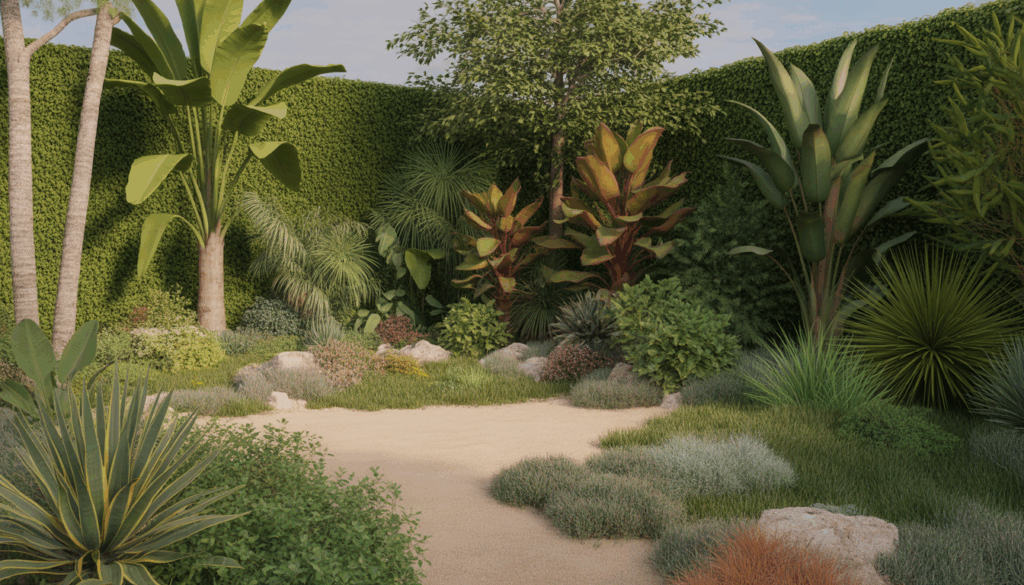How to Choose Plants That Thrive in Your Climate for a Vibrant Backyard
I have been, or can be if you click on a link and make a purchase, compensated via a cash payment, gift, or something else of value for writing this post. As an Amazon Associate, I earn from qualifying purchases. Please read my full Affiliate Disclosure for more information.
To choose plants that thrive, start by mapping your climate zones and your yard’s microclimates—sun hours, wind, drainage, and heat pockets vary even on a single property. Match plants to your soil texture, drainage, and pH, then group those with similar water needs to conserve moisture and reduce waste. Consider sun exposure from full sun to shade, and pick drought-tolerant or moisture-loving species accordingly. Small, data-backed adjustments over seasons will sharpen results—you’ll find a more resilient, colorful setup. More tips await.
Key Takeaways
- Map your local climate and microclimates to match plant choices with sun, wind, drainage, and temperature patterns.
- Group plants by similar water needs and soil tolerances to optimize irrigation and soil amendments.
- Assess soil health (texture, pH, organic matter) and amend to improve drainage and nutrient availability.
- Prioritize drought- and heat-tolerant species for sunny, hot spots and choose shade-loving varieties for cool, shaded zones.
- Plan seasonal timing, spacing, and barriers to ensure airflow, protection from storms, and year-round visual interest.
Reading Climate Zones: A Practical Guide
Reading climate zones helps you match plants to your region by outlining average temperature ranges, seasonal shifts, and frost patterns. You’ll see how a plant zone aligns with climate classification, guiding your choices without guesswork. The system pairs hardiness with regional conditions, translating complex maps into actionable steps. You’ll compare zone numbers, summer heat, winter lows, and rainfall patterns to determine suitability. This pragmatic approach emphasizes reliability over novelty, focusing on data you can verify. By understanding zone boundaries, you can prioritize seasonal timing, minimize disaster risk, and select resilient species that fit your landscape’s actual climate profile.

Assessing Your Microclimates for Better Plant Picks
Microclimates can shift a plant’s performance even within the same climate zone, so you’ll want to map the small-scale differences across your yard. You’ll observe sun exposure, wind, heat buildup, and drainage to identify microclimate zones that influence growth and stress. Record data over seasons, compare against species’ tolerance, and note where beds stay cooler or drier than expected. This approach helps you anticipate plant adaptation needs and select resilient choices. Clear mapping reduces surprises and guides smarter purchases. A data-driven mindset boosts success in any yard.
- You’ll see sun/shade patterns shaping outcomes
- Wind corridors alter moisture and vigor
- Heat pockets stress or accelerate growth
- Drainage spots inform rooting comfort
- Seasonal shifts refine microclimate zones understanding
Matching Water Needs to Local Conditions
Water needs aren’t one-size-fits-all; they hinge on local conditions like sun exposure, wind, soil type, and drainage. In practice, you’ll map how often you water, based on plant roots’ access to moisture and evaporation rates you observe over seasons. Track rainfall patterns, soil moisture, and irrigation efficiency to tailor routines. Use rainwater harvesting where possible to reduce municipal use and adapt to runoff, soil texture, and drainage. Group plants by similar water needs, favoring drought tolerant landscaping for drier periods. Adjust schedules after heavy rains, and monitor signage or soil probes to avoid overwatering and root disease.
Sunlight Patterns: Full Shade to Full Sun
Sunlight patterns determine where plants perform best, from deep shade to blazing sun, and they’re shaped by factors like building orientation, tree cover, and seasonal shadows. You’ll map sun hours across seasons to choose resilient combos, balancing decor and function. Measurements guide plant selection, reducing guesswork and boosting success.
- Sun exposure shifts through the day, affecting color and growth
- East-facing spots wake plants with gentle morning light
- Afternoon sun demands heat- and drought-tolerant varieties
- Partial shade supports understories and garden decor contrast
- Consistent light helps pest control by reducing damp, cluttered corners
Soil Types and Amendments That Support Local Plants
Soil types and the right amendments are the backbone of plant success, especially when you tailor choices to local conditions; understanding texture, drainage, and organic content helps you pick resilient species and avoid common pitfalls. You’ll assess soil composition through simple tests that reveal pH, nutrients, and structure, guiding decisions about drainage improvements or lime and organic matter additions. Amendments and testing should be iterative, not one-and-done, so you can refine for seasonally shifting needs. Focus on drainage, microbial activity, and compaction, then match plants to your site based on data-informed tolerances and long-term performance.
Selecting Native and Adapted Species
Selecting native and adapted species starts with a clear view of your site’s conditions and your long-term goals, then matches plants to those realities rather than trends. You’ll prioritize species proven by local data, reducing maintenance and input needs. This approach boosts ecosystem function, supports pollinator attraction, and enhances pest resistance through diverse, resilient plantings. By comparing drought tolerance, soil compatibility, and mature size, you choose wisely rather than impulse-buy. Track performance across seasons to refine choices. Ground your decisions in objective metrics, not hype, and align selections with your climate window and garden function.
- Works with local soils and microclimates
- Supports pollinator networks
- Minimizes pest outbreaks through diversity
- Reduces irrigation and fertilizer needs
- Matches long-term maintenance expectations
Seasonal Timing for Planting and Maintenance
You’ll want to align planting windows with local climate data and soil conditions to maximize establishment and growth. Tracking seasonal care timing—like when to water, fertilize, or prune—helps prevent stress and supports consistent yields of vigor. By starting with clear, evidence-based timing guidelines, you can tailor maintenance plans to your specific zone and microclimate.
Planting Windows
What are the best times to plant and maintain, and how do seasonal windows influence success? You’ll notice that planting windows, when temperatures and rainfall align, predict establishment. By tracking local frost dates, soil temperature, and upcoming rain, you choose ideal planting times for seedlings and perennials. Short, reliable windows reduce stress on roots and improve survival rates. Consistency matters: align maintenance with the same seasonal cues to minimize drought and heat shocks. Your planning informs better water use and weed control, maximizing early growth and long-term vigor.
- Clear frost-free timing guides confidence and accuracy
- Consistent soil warmth supports root establishment
- Rain-friendly windows reduce irrigation needs
- Early prep boosts transplant success
- Data-driven decisions increase garden resilience
Seasonal Care Timing
Seasonal Care Timing builds on the concept that planting windows aren’t just about when to put seeds in the ground, but also about how to schedule ongoing care. You’ll align fertilizer schedules with growth stages, soil tests, and rainfall patterns, avoiding over‑ or under‑feeding. Monitor plant responses—leaf color, growth rate, and flowering—to adjust timing rather than guesswork. Pruning techniques should follow objective needs, not calendar dates, preserving structure and air flow while reducing stress. Document every adjustment, compare outcomes year over year, and refine intervals. A data‑driven plan minimizes waste, supports resilience, and sustains significance across seasons.
Practical Tips for Protecting Plants From Weather Extremes
To protect your plants from heat, wind, and storms, you’ll want practical barriers and strategic placement that reduce exposure while maximizing airflow. Data shows shade cloth, windbreaks, and mulching can cut stress indicators and conserve soil moisture, with temperature-smart watering matching demand. Start by evaluating your site’s worst weather points and then implement targeted measures for Shielding Plants From Heat, Wind and Storm Barriers, and Temperature-Smart Watering.
Shielding Plants From Heat
Shielding plants from heat starts with understanding how weather stress shows up in your garden. You’ll notice faster leaf scorch, wilting during peak sun, and delayed growth when soil dries quickly. Data shows microclimates matter: south-facing beds heat up first, while shaded spots stay steadier. Using evidence, you can reduce stress with simple tactics like timing irrigation, mulching deeply, and spacing for airflow. Shade cloths and heat shields can lower leaf temperatures by several degrees, preserving color and essentiality.
- Observe sun hours and microclimates before intervention
- Irrigate deeply, not just surface water
- Mulch to retain moisture
- Space plants for airflow
- Use shade cloths or heat shields as needed
Wind and Storm Barriers
Wind and storm barriers reduce wind chill and physical damage by creating still air pockets and redirecting gusts away from vulnerable tissue. You’ll notice calmer microclimates behind barriers, with reduced transpiration stress and fewer leaf tears. Use windbreak design principles: position barriers to shield at critical heights, staggered spacing to break turbulence, and select dense, evergreen species for year-round protection. For flexibility, combine solid screens with permeable plantings to balance airflow and light. Integrate storm resistant shrubs along property edges to absorb impact and stabilize soils. Test wind models on-site, adjust layouts seasonally, monitor plant recovery, and refine your strategy.
Temperature-Smart Watering
When temperatures swing, smart watering isn’t just about soil moisture—it’s about timing, delivery, and durability; drip irrigation with soil moisture sensors lets you dial in watering to the plant’s needs, reducing stress during heat waves and frost events. You’ll protect roots, conserve water, and minimize disease risk by aligning irrigation with forecasted highs and lows, while mulching techniques shield the soil and regulate temperature.
- Monitor soil steadily to anticipate stress
- Use drip irrigation for precise delivery
- Pair with mulching techniques to conserve moisture
- Schedule adjustments for heat waves and freezes
- Track outcomes to refine your approach
Designing a Colorful, Low-Muss Backyard
A colorful, low-muss backyard is achievable when you choose plants that thrive in your climate, require minimal care, and pair well with your sun and soil conditions. You’ll base color choices on bloom periods and foliage texture, then layer accents thoughtfully. Data show native perennials reduce maintenance and irrigation needs while boosting pest resilience. Combine drought-tolerant grasses with low-water shrubs for year-round structure, and place bright annuals where eye contact occurs from seating areas. Integrate garden art as focal points and use outdoor furniture for functional color blocks. The result is cohesive, resilient, and visually engaging.
Monitoring Performance and Adjusting Your Plan
Monitoring how your colorful, low-muss backyard performs after planting helps you verify that it meets your goals and stays resilient. You track outcomes with plant growth monitoring, noting height, vigor, and bloom timing, then compare to forecasts. When issues arise, you quantify symptoms, seasonality, and geographic context before acting. Pest detection becomes a trigger for timely adjustments, not alarm. From data, you refine watering, soil, and light plans, bolstering longevity. With measured steps, you turn feedback into clarity, confidence, and sustainable progress.
- You’ll feel informed, not overwhelmed, by clear benchmarks
- Results guide precise, gentle interventions
- Patterns reveal true resilience
- Early signals prevent cascading problems
- Confidence grows as understanding deepens
Conclusion
You’ve mapped your climate, microclimates, and water dynamics, so your backyard isn’t random—it’s data-informed. Track sun exposure, soil texture, and seasonal shifts, then test plant responses over time. Favor proven locals and drought-tolerant varieties where appropriate, refining choices as weather clues evolve. Quick adjustments—mulching, shading, or irrigation tweaks—keep success steady. With ongoing observation and notes, you’ll steadily optimize the palette, timing, and resilience, ending with a vibrant, low-maintenance outdoor space that truly thrives.






